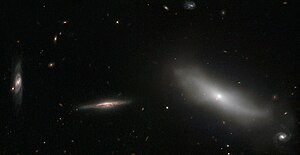NGC 1190
| Galaxy NGC 1190 |
|
|---|---|

|
|
| Photo from the Hubble Space Telescope : NGC 1190 is on the right, the other galaxies are background objects. | |
| AladinLite | |
| Constellation | Eridanus |
|
Position equinox : J2000.0 , epoch : J2000.0 |
|
| Right ascension | 03 h 03 m 26.1 s |
| declination | -15 ° 39 ′ 43 ″ |
| Appearance | |
| Morphological type | S0 |
| Brightness (visual) | 14.2 mag |
| Brightness (B-band) | 15.2 mag |
| Angular expansion | 0.9 ′ × 0.3 ′ |
| Position angle | 95 ° |
| Surface brightness | 12.4 mag / arcmin² |
| Physical data | |
| Affiliation | HCG 22 |
| Redshift | 0.008733 ± 0.000090 |
| Radial velocity | 2618 ± 27 km / s |
|
Stroke distance v rad / H 0 |
(115 ± 8) x 10 6 ly (35.2 ± 2.5) Mpc |
| history | |
| discovery | Francis P. Leavenworth |
| Discovery date | December 2, 1885 |
| Catalog names | |
| NGC 1190 • PGC 11508 • MCG -03-08-062 • 2MASX J03032612-1539429 • HCG 22B • GALEX ASC J030326.14-153942.4 | |
NGC 1190 is a lenticular galaxy of the Hubble type S0 in the constellation Eridanus in the southern sky . It is estimated to be 115 million light years away from the Milky Way and has a diameter of about 30,000 ly. Together with NGC 1189 , NGC 1191 , NGC 1192 and NGC 1199 , it forms the galaxy group HCG 22 .
The object was discovered on December 2, 1885 by the astronomer Francis Preserved Leavenworth .
Web links
Commons : NGC 1190 - collection of images, videos, and audio files
